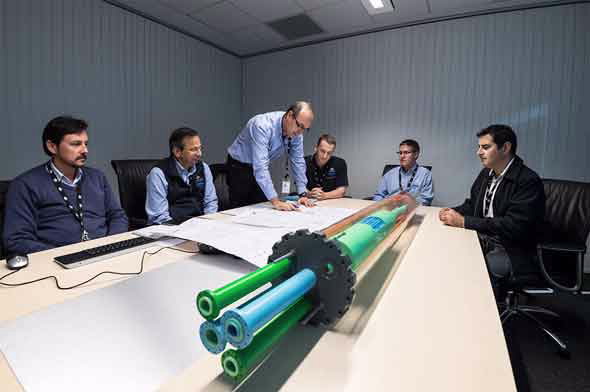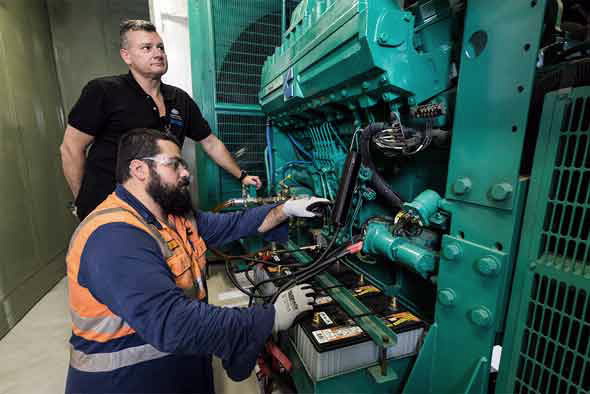Part 1: Morning
6:00am
In the reactor’s main control room, a highly trained and capable operator is about to hand over responsibility to a fellow reactor operator. They go over changes in the status of systems and any other pertinent events that occurred during the night. This is an environment in which everything is carefully planned, implemented, checked and reviewed. Safety and compliance with nuclear regulations are paramount. The operator takes one last look at the eight system monitors and relinquishes his chair.
 |
| Reactor operators Jeffrey Watson (left) and Gregory Lay in the OPAL control room |
8:00am
Every day, Reactor Operations runs a meeting to briefly look at what occurred in the previous 24 hours, review events, assess if anything needs attention, set priorities, review risks and go over the schedule for the coming weeks. Jason Chakovski, OPAL Operations Manager, will oversee the gathering. The Reactor Manager David Vittorio will be there with other key representatives from diverse teams across Nuclear Operations.
 |
| A representative team from nuclear operations meets every morning to discuss the day ahead |
Jason Chakovski, like all of the people who work in Nuclear Operations, is very proud of the performance and safety record of OPAL. The reactor achieves over 98 per cent reliability and recently reached a milestone of more than 300 days at power over a twelve month period. “It’s about determining what you want from an asset and based on that, finding the right balance between performance, system operations and strategy. We have put a lot of effort into our operations and asset management strategy, working with the various teams to get it right.”
OPAL Operations Manager, Jason Chakovski Predictive maintenance and predictive risk management are key processes. “We can foresee our risks and manage those risks before they have the opportunity to impact operations,” said Chakovski, OPAL has a level of defence-in-depth that ensures there is a safety net at all times.
Chakovski is convinced it is the people who work at OPAL who have made it a great reactor. ”We have a high level of engagement in the success of the reactor. They know the importance of the nuclear medicine it is producing and the people waiting for it. They are proud that what they are doing is important.”
9:00am
Cristina Flego has just finished reviewing a submission prepared by an instrumentation engineer in her team, that will enable the Instrumentation and Control group to qualify their instrumentation in-house to nuclear grade standards.
 |
| Aaron Mikrut and Cristina Flego of the Instrumentation and control team |
Although there are specialist systems for radiation monitoring and neutron flux, most of the instrumentation and control for the reactor is standard and monitors physical processes like pressure, temperature and flow. OPAL has a number of instrumentation systems, two of which are used to shut down the reactor automatically.
“The thing that is special about our safety systems is that they are qualified for application in the nuclear industry,” said Cristina Flego, team leader, who is an electrical engineer.
The instrumentation and control group has primary responsibility for system engineering of OPAL’s instrumentation systems and other process instrumentation.
“All our systems have instrumentation.” The group look after a variety of systems including the Reactor Control and Monitoring System, safety shutdown systems, post-accident monitoring system, and process radiation monitoring (for example, on the secondary cooling system and waste systems) and supports the process and mechanical engineers.
“The instrumentation systems work very well. It’s fairly uneventful day to day and we like it that way,” said Flego.
10:00am
Heath Davis is doing his daily power check using the reactor control and monitoring system to ensure the reactor is operating at optimal power.
To return the reactor to power following a scheduled shutdown, a specific procedure is used which outlines all the steps to take the reactor from a shutdown state to full power.
Reactor Operator Heath Davis “There are many parameters that have to be satisfied, forms completed and checks done before we get the go ahead,” said Reactor Operator Heath Davis. It is very systematic. Everything has to be started in the right order, which concludes with a predetermined control rod movement strategy.
Raising the control rods from the core, initiates the fission reaction that produces neutrons. Raising power to capacity is a slow and methodical procedure that ensures everything maintains equilibrium. The automatic reactor power control system cannot be engaged until two instruments are within one per cent agreement.
“At that stage, it will maintain the power at a selected level until we instruct it to make a change.”
Part of the shift pattern of work involves swapping roles to act as a reactor operator based in the Main Control room or in the plant.
“Most people don’t get to do what we do, operating a nuclear reactor.” Nuclear reactor operators undergo extensive training and accreditation.
10:30am
A group of specialists form across Reactor Operations are meeting to discuss progress on the major capital project which will upgrade a key component of the reactor, the Cold Neutron Source (CNS). The CNS provides a supply of neutrons at 20 degree Kelvin to lower their energy. Cold neutrons are used in neutron scattering instruments to study the structure and properties of materials.
 |
| Some members of the Cold Neutron Source upgrade project team (left to right) Scott Hopkins, Ashok Sah, Walter Bermudez, Joel Forbes, Chris Humphries and Andrew Eltobaji |
11:00am
Grant Frazer has just met with Joe, the contractor from Cummins Power Generation to review his safe work method statement and issue a safe work permit. Joe will then check and service the reactor’s three standby diesel generators within OPAL’s restricted area.
 |
| Logistics Support team member Grant Frazer (left) and contractor, Joe check a back-up generator for the reactor |
Published: 05/09/2016The logistics support team are the ‘go to’ guys in reactor operations for many people as they provide such diversified support throughout a multi-faceted plant.
Grant Frazer likes the variety of tasks he gets to assist with on any given day, from sourcing a critical spare part from the US for an OPAL system engineer, assembling an abseiling team to hang banners on the front of the reactor, arranging security clearances and access, completing payments for contractor services or initiating a new service level agreement.
“We employ the ANSTO factor….that is it may take longer than normal, however, be patient, do it safely and properly,” said Frazer.
The highly regulated and supervised environment can be a little out of the ordinary and somewhat unusual to some contractors.
Being responsible for many contractor organisations servicing plant including air conditioning and refrigeration, reactor water chemical dosing, demineralised water production, compressed air and other services, as well as an array of one-off project jobs, keeps the two man logistics support team ’on the go’.




